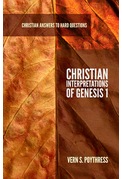A Brief Book Summary from Books At a Glance
by Steve West
About the Author
Vern Poythress (PhD, Harvard University; ThD, University of Stellenbosch) is distinguished professor of New Testament and biblical interpretation at Westminster Seminary, Philadelphia. He is the author of numerous books and articles.
Introduction
In this booklet, Vern Poythress outlines the strengths and weaknesses of various Christian interpretations of Genesis 1. He succinctly presents the main point of each view, and then also identifies the lynchpin issues for each position.
Summary
Is there a contradiction between the mainstream claims that the universe is 14 billion years old and the description in Genesis of creation in six days? Some dismiss the Bible as inaccurate, but it is the Word of God and cannot be mistaken. The biggest division amongst Christian interpreters is in regards to understanding the lengths of the six days. Some believe that the world is only thousands of years old and the days are 24 hours long. Amongst those who hold to a young earth, there are some who add the nuance that the world was created in a mature form, so it has the appearance of age. As an example, Adam was created as an adult and not as a baby, so he had the appearance of being older than he was. Other interpreters suggest that the six days were the days over which God revealed his creative work to the author of Genesis (this is called the revelatory-day theory). Gap theorists think that there is a long period of time between Genesis 1:1 and 1:2, with 1:3-31 describing a re-creation. The intermittent-day theory claims that the days were 24 hours long, but that there were long periods of time between them.
Other approaches do not see the days as being 24 hours long. The day-age theory maintains that each day in Genesis 1 is representative of a long period of time. In Hebrew, the word “day” can refer to a period of time and not only to a 24-hour day. The analogical-day theory sees the days in Genesis 1 as being God’s work days, which are then analogous to human work days. God’s work days, however, may not be 24 hours. The framework hypothesis suggests that the days are a literary structure that shows how God’s design in creation was ordered; they are literary frames and not temporal markers. Other interpreters believe that Genesis 1 is only intended to teach religious truths, and as a result, it is not concerned with scientific detail. . . .
[To continue reading this summary, please see below....]The remainder of this article is premium content. Become a member to continue reading.
Already have an account? Sign In
Buy the books

CHRISTIAN INTERPRETATIONS OF GENESIS 1, by Vern S. Poythress